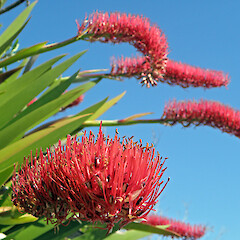Xeronema callistemon f. callistemon
Common name
Poor Knights lily, raupō-Taranga
Synonyms
Xeronema callistemon W.R.B.Oliv., Xeronema callistemon W.R.B.Oliv. var. callistemon
Family
Xeronemataceae
Flora category
Vascular – Native
Endemic taxon
Yes
Endemic genus
No
Endemic family
No
Structural class
Herbs - Monocots
Chromosome number
2n = 34, 36
Current conservation status
The conservation status of all known New Zealand vascular plant taxa at the rank of species and below were reassessed in 2017 using the New Zealand Threat Classification System (NZTCS) – more information about this can be found on the NZTCS website. This report includes a statistical summary and brief notes on changes since 2012 and replaces all previous NZTCS lists for vascular plants.
Please note, threat classifications are often suggested by authors when publications fall between NZTCS assessment periods – an interim threat classification status has not been assessed by the NZTCS panel.
- Conservation status of New Zealand indigenous vascular plants, 2017 . 2018. Peter J. de Lange, Jeremy R. Rolfe, John W. Barkla, Shannel P. Courtney, Paul D. Champion, Leon R. Perrie, Sarah M. Beadel, Kerry A. Ford, Ilse Breitwieser, Ines Schönberger, Rowan Hindmarsh-Walls, Peter B. Heenan and Kate Ladley. Department of Conservation. Source: NZTCS and licensed by DOC for reuse under the Creative Commons Attribution 4.0 International licence.
2017 | At Risk – Naturally Uncommon | Qualifiers: CD, IE, RR
Previous conservation statuses
2012 | At Risk – Naturally Uncommon | Qualifiers: CD, IE, RR
2009 | At Risk – Naturally Uncommon | Qualifiers: IE
2004 | Range Restricted
Distribution
Endemic. Only known from the Poor Knights Islands near Tutukaka, and from Hen (Taranga) Island,near Whangarei. Xeronema belongs to a newly established family of one genus with two species, the Xeronemataceae.
Habitat
Rhyolite sea cliffs and rock outcrops. Occasionally in forest on rubble or as an epiphyte on pohtukawa (Metrosideros excelsa). These latter occurrences probably stem from fallen plants captured in trees or resprouting on the forest floor.
Detailed description
Forming huge colonies 1-4 m across. Leaves green to yellow-green, arising from thick rhizomes, and forming flattened fans, 60-150 x 3-5 cm, Dead leaves long persistent, ultimately detached from the frayed base to form a fibrous mass. Inflorescences on green, thick, leafy stems (peduncle) up to 1 m. Racemes 10-60 cm long, aligned vertically on upper side of peduncle. Flowers crowded, numerous. Flower stalks (pedicels) 1-15 mm long, subtended by an pale green translucent leafy bract, which is obviously shorter than the buds. Flowers red, tepals 10-15 mm, outer 3 mm wide, inner 1.5 mm. Stamen filaments twice length of tepals, anthers 4 mm long, pollen tangerine-orange. Ovary 4 x 2 mm, oblong-3-angled, covered with copious nectar. Capsule 9-11 mm. Seeds ovate, 1.6 x 1 mm, black.
Similar taxa
None in New Zealand. Similar to X. moorei of New Caledonia (the only other species of the genus, and family), which differs in some floral and capsule details, and by the seed size and shape. X. callistemon f. callistemon differs from f. bracteosa only in one character, the much shorter pale green to translucent floral bracts, which are shorter than the emerging flower buds.
Flowering
September to December, peaking in October.
Flower colours
Orange, Red/Pink
Fruiting
November to January.
Propagation technique
Very easy from divisions of whole plants, and seed. But seed must be fresh, and though germinating easily can take 10-15 years to reach flowering size. Xeronema is best grown in a long narrow pot, within a free draining mix of rock chips and compost. Plants should be watered frequently, and frequently fertilised with sea weed, manure, or high phosphate/nitrogen garden fertilisers. They should be allowed to become root bound (or they will not flower), and need high sunlight. Plants are very cold sensitive, dying in even mild frosts.
Threats
None. The specie sis liste donly because it is endemic to two very small island archipelago.
Etymology
xeronema: From the Greek xeros ‘dry’ and nema ‘thread’
callistemon: With a beautiful stamen
Where To Buy
Becoming more common in cultivation, and easily obtained from most garden centres.
Attribution
Fact Sheet prepared for NZPCN by P.J. de Lange 1 October 2004. Description based on Moore & Edgar (1970) supplemented by observations obtained from fresh specimens and herbarium material (see also de Lange & Cameron 1999).
References and further reading
de Lange, P.J.; Cameron, E.K. 1999: The vascular flora of Aorangi Island, Poor Knights Islands, northern New Zealand. New Zealand Journal of Botany 37: 433-468.
Moore, L.B.; Edgar, E. 1970: Flora of New Zealand. Vol. II. Wellington, Government Printer.
NZPCN Fact Sheet citation
Please cite as: de Lange, P.J. (Year at time of access): Xeronema callistemon f. callistemon Fact Sheet (content continuously updated). New Zealand Plant Conservation Network. https://www.nzpcn.org.nz/flora/species/xeronema-callistemon-f-callistemon/ (Date website was queried)















